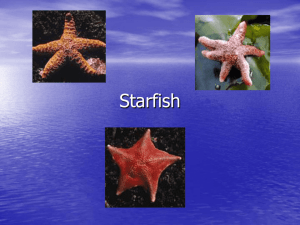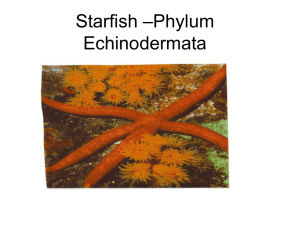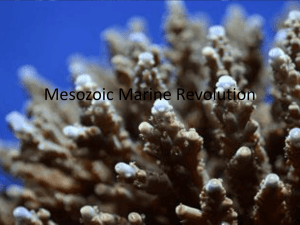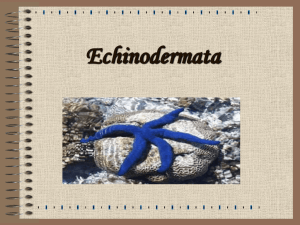starfish dissection
advertisement
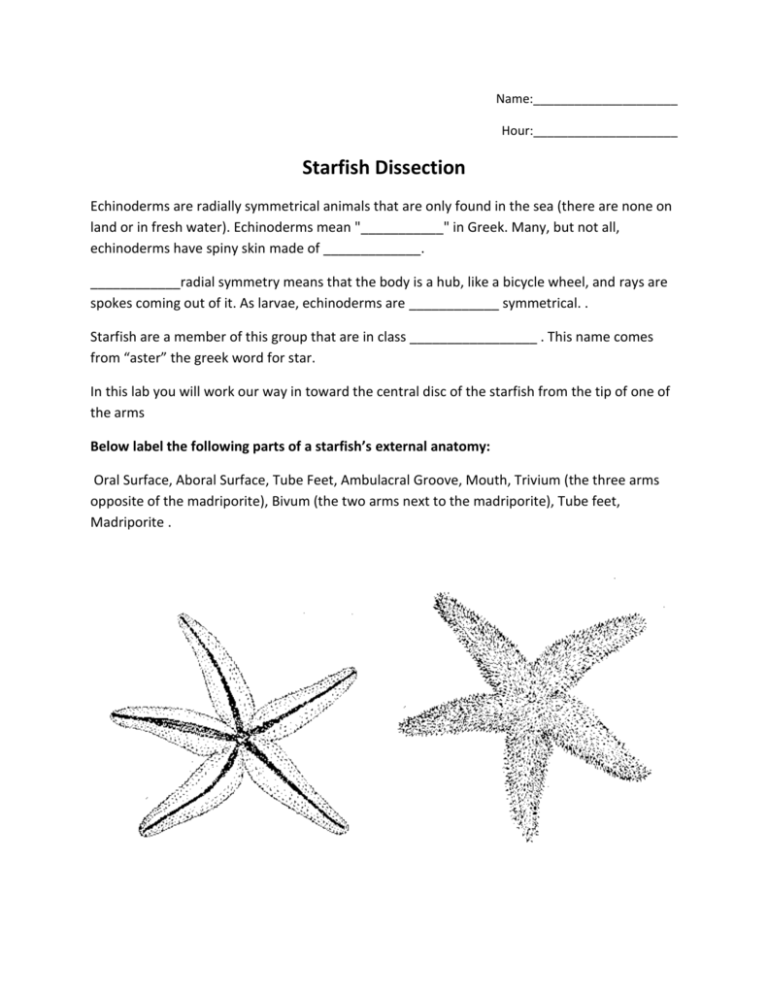
Name:_____________________ Hour:_____________________ Starfish Dissection Echinoderms are radially symmetrical animals that are only found in the sea (there are none on land or in fresh water). Echinoderms mean "___________" in Greek. Many, but not all, echinoderms have spiny skin made of _____________. ____________radial symmetry means that the body is a hub, like a bicycle wheel, and rays are spokes coming out of it. As larvae, echinoderms are ____________ symmetrical. . Starfish are a member of this group that are in class _________________ . This name comes from “aster” the greek word for star. In this lab you will work our way in toward the central disc of the starfish from the tip of one of the arms Below label the following parts of a starfish’s external anatomy: Oral Surface, Aboral Surface, Tube Feet, Ambulacral Groove, Mouth, Trivium (the three arms opposite of the madriporite), Bivum (the two arms next to the madriporite), Tube feet, Madriporite . Place your starfish dorsal side up in the pan. *Snip off the tip of any ray of the starfish. CAUTION: Always be careful with scissors. With scissors, remove the skeleton from the top of the ray using Figure 2 as a guide. DO NOT cut into the central disc or into the soft tissue below the skeleton. Digestive System (Pyloric Cecum) The large gland filling each entire ray is the pyloric ceca. This digestive gland is part of the digestive system. Reproductive Organ (Gonad) Starfish have separate sexes. During spawning, the gonads are large. At other times, they are small. Our starfish specimens may have greatly reduced gonads so we will not be able to view them. Gonads can be distinguished by color. Testes are gray; ovaries are orange. NOTE: Preserved starfish parts may lose their true colors. *Remove the entire digestive gland from the dissected ray of your starfish. *Locate a ridge running along the bottom center of the ray. This ridge resembles a zipper. Away from the tip end of the ray and along each side of this ridge are the gonads. They are two pale, lumpy organs. 1. Why would a starfish reduce the size of its gonads when it is not in the breeding season? Digestive System *Carefully cut away the top surface of the central disk. Do not remove the madriporite at this time. Cut around it. A large saclike part, the stomach, should now be visible. The stomach takes up almost all of the central disk area. Small tubes may be seen extending into each arm. These tubes connect the stomach to the digestive gland. How many stomachs are present in a starfish? _________ 2a. On which surface is the mouth located? _____________________ b. Where is the mouth in relation to the stomach?_____________________________________ 3a. On which surface is the anus? __________________________________________________ b. Where is the anus in relation to the stomach? ______________________________________ Below label the following parts of the starfhish’s internal anatomy : Digestive System: Pyloric stomach, Pyloric Cecum, Anus, Cardiac Stomach, Pyloric Duct Water vascular system *Remove the skeleton from the top of the other four rays. *Remove all of the digestive glands, stomach, and gonads. Do not remove the madriporite or anything connected to it. The remaining structures in your starfish are its water vascular system. the water vascular system consists as a series of hallow tubes. Essentially, water enters in through the madriporite and moves through these canals to the entire organism. Look along the zipperlike ridge which extends the entire length of each ray of the starfish. Ampullae are bulblike and clear in color. Each ampulla is connected to another tube foot which extends through the skeletal plates into the animal’s underside. Pressure changes due to the movement of fluids inside these structures enable starfish to completely relax muscles in each ampulla and tube foot. the tube feet act as tiny suction cups that grip objects. Inside the ambulacral groove is a long hallow tube wich runs the full length of each arm. these are called radial canals. they are not visible in your preserved specimen. radial canals are connected to all the tube feet. 4. What is the human vascular system used for? 5. What is the starfish’s vascular system used for? 6. How many stone canal(s) does a starfish have?______ 7. How many radial canal(s) does a starfish have?______ Label the following in the diagram below: Madriporite, Stone Canal, Ring Canal, Radial Canal, Ampullae,

